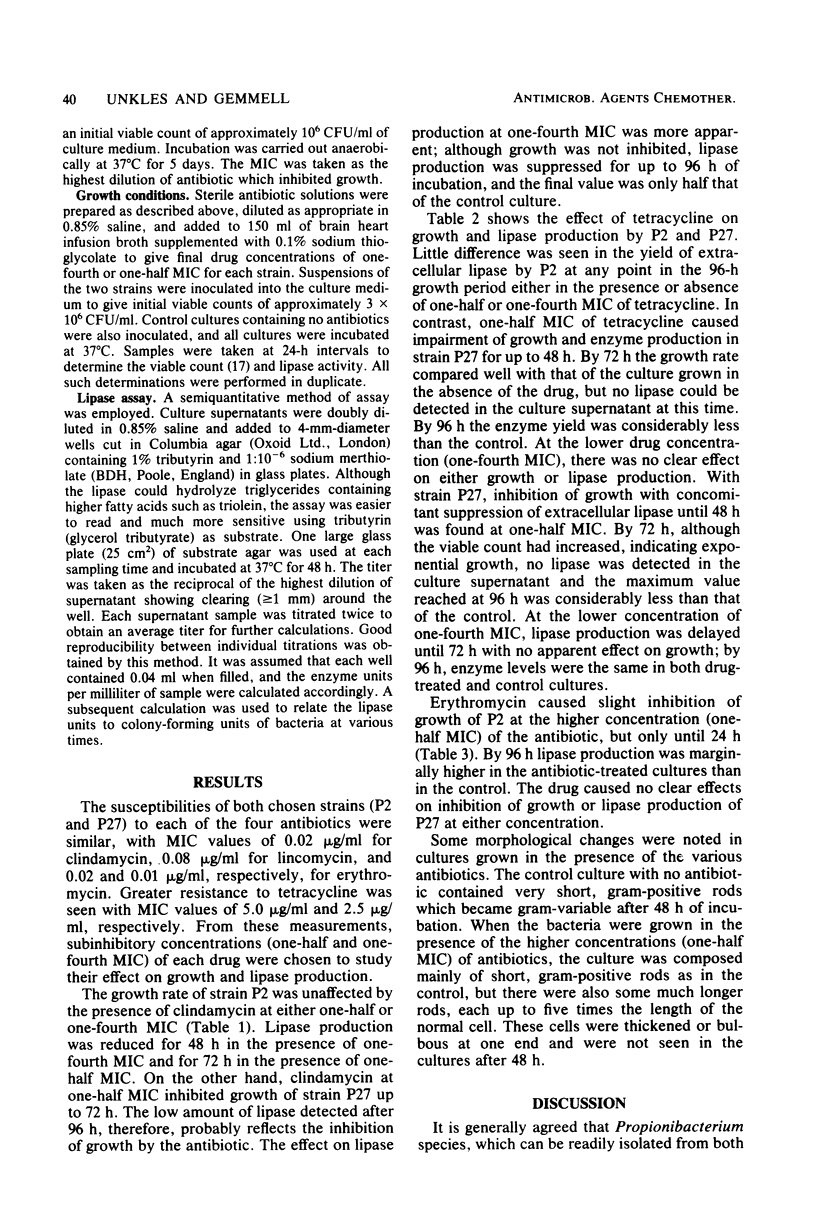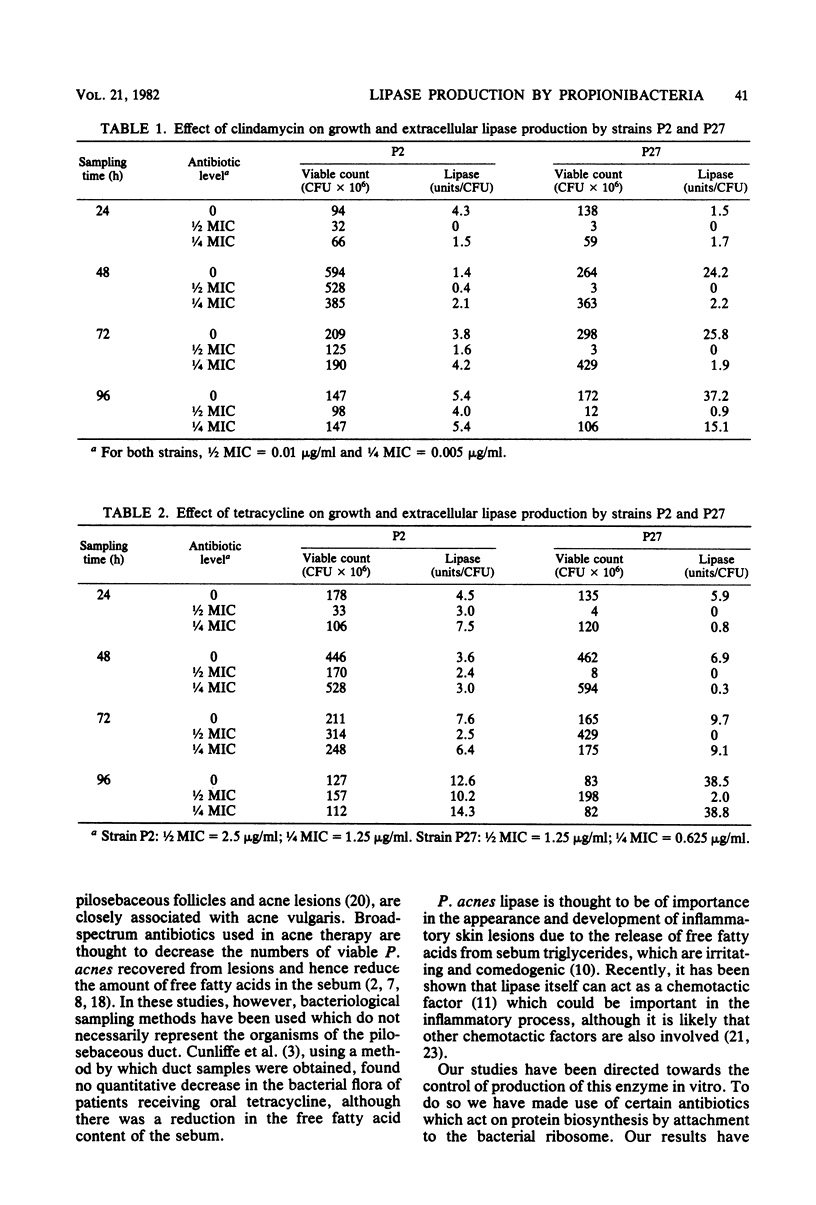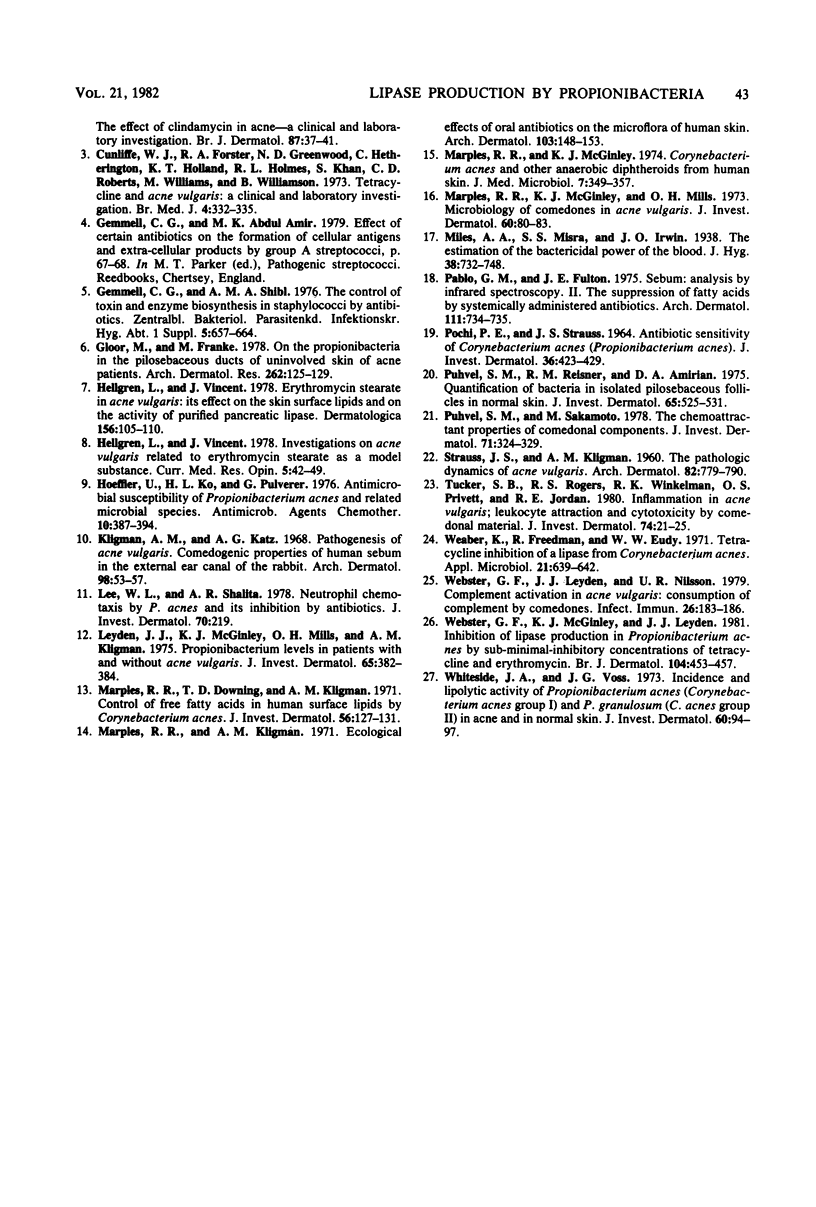Abstract
Two propionibacteria identified as Propionibacterium acnes and Propionibacterium granulosum were grown anaerobically in the presence of growth subinhibitory concentrations (0.25 and 0.5 minimal inhibitory concentrations) of clindamycin, erythromycin, lincomycin, and tetracycline. Viable counts and assays of extracellular lipase were performed on samples taken at 24-h intervals over a 96-h period. The results showed that lincomycin and clindamycin could inhibit the production of the enzyme by both strains with little effect on their growth rates. Tetracycline caused inhibition of lipase production by P. granulosum only. Although production of the enzyme by P. acnes was delayed in the presence of tetracycline, the final titer was the same as the control. Erythromycin had little effect on growth and enzyme production of either strain. It is possible, therefore, that certain antibiotics used in acne therapy may act not only as bactericidal agents but also as inhibitors of enzyme production under non-growth-limiting conditions.
Full text
PDF




Selected References
These references are in PubMed. This may not be the complete list of references from this article.
- Cunliffe W. J., Cotterill J. A. Clindamycin as an alternative to tetracycline in severe acne vulgaris. Practitioner. 1973 May;210(259):698–700. [PubMed] [Google Scholar]
- Cunliffe W. J., Cotterill J. A., Williamson B. The effect of clindamycin in acne--a clinical and laboratory investigation. Br J Dermatol. 1972 Jul;87(1):37–41. doi: 10.1111/j.1365-2133.1972.tb05095.x. [DOI] [PubMed] [Google Scholar]
- Cunliffe W. J., Forster R. A., Greenwood N. D., Hetherington C., Holland K. T., Holmes R. L., Khan S., Roberts C. D., Williams M., Williamson B. Tetracycline and acne vulgaris: a clinical and laboratory investigation. Br Med J. 1973 Nov 10;4(5888):332–335. doi: 10.1136/bmj.4.5888.332. [DOI] [PMC free article] [PubMed] [Google Scholar]
- Gloor M., Franke M. On the propionibacteria in the pilosebaceous ducts of uninvolved skin of acne patients. Arch Dermatol Res. 1978 Jun 29;262(1):125–129. doi: 10.1007/BF00455579. [DOI] [PubMed] [Google Scholar]
- Hellgren L., Vincent J. Erythromycin stearate in acne vulgaris: its effect on the skin surface lipids and on the activity of purified pancreatic lipase. Dermatologica. 1978;156(2):105–110. doi: 10.1159/000250905. [DOI] [PubMed] [Google Scholar]
- Hoeffler U., Ko H. L., Pulverer G. Antimicrobiol susceptibility of Propinibacterium acnes and related microbial species. Antimicrob Agents Chemother. 1976 Sep;10(3):387–394. doi: 10.1128/aac.10.3.387. [DOI] [PMC free article] [PubMed] [Google Scholar]
- Kligman A. M., Katz A. G. Pathogenesis of acne vulgaris. I. Comedogenic properties of human sebum in external ear canal of the rabbit. Arch Dermatol. 1968 Jul;98(1):53–57. doi: 10.1001/archderm.98.1.53. [DOI] [PubMed] [Google Scholar]
- Leyden J. J., McGinley K. J., Mills O. H., Kligman A. M. Propionibacterium levels in patients with and without acne vulgaris. J Invest Dermatol. 1975 Oct;65(4):382–384. doi: 10.1111/1523-1747.ep12607634. [DOI] [PubMed] [Google Scholar]
- Marples R. R., Downing D. T., Kligman A. M. Control of free fatty acids in human surface lipids by Corynebacterium acnes. J Invest Dermatol. 1971 Feb;56(2):127–131. doi: 10.1111/1523-1747.ep12260695. [DOI] [PubMed] [Google Scholar]
- Marples R. R., Kligman A. M. Ecological effects of oral antibiotics on the microflora of human skin. Arch Dermatol. 1971 Feb;103(2):148–153. [PubMed] [Google Scholar]
- Marples R. R., McGinley K. J. Corynebacterium acnes and other anaerobic diphtheroids from human skin. J Med Microbiol. 1974 Aug;7(3):349–357. doi: 10.1099/00222615-7-3-349. [DOI] [PubMed] [Google Scholar]
- Marples R. R., McGinley K. J., Mills O. H. Microbiology of comedones in acne vulgaris. J Invest Dermatol. 1973 Feb;60(2):80–83. doi: 10.1111/1523-1747.ep12724149. [DOI] [PubMed] [Google Scholar]
- POCHI P. E., STRAUSS J. S. Antibiotic sensitivity of Corynebacterium acnes (Propionibacterium acnes). J Invest Dermatol. 1961 Jun;36:423–429. doi: 10.1038/jid.1961.66. [DOI] [PubMed] [Google Scholar]
- Pablo G. M., Fulton J. E., Jr Sebum: analysis by infrared spectroscopy. II. The suppression of fatty acids by systemically administered antibiotics. Arch Dermatol. 1975 Jun;111(6):734–735. doi: 10.1001/archderm.111.6.734. [DOI] [PubMed] [Google Scholar]
- Puhvel S. M., Reisner R. M., Amirian D. A. Quantification of bacteria in isolated pilosebaceous follicles in normal skin. J Invest Dermatol. 1975 Dec;65(6):525–531. doi: 10.1111/1523-1747.ep12610239. [DOI] [PubMed] [Google Scholar]
- Puhvel S. M., Sakamoto M. The chemoattractant properties of comedonal components. J Invest Dermatol. 1978 Nov;71(5):324–329. doi: 10.1111/1523-1747.ep12529815. [DOI] [PubMed] [Google Scholar]
- Tucker S. B., Rogers R. S., 3rd, Winkelmann R. K., Privett O. S., Jordon R. E. Inflammation in acne vulgaris: leukocyte attraction and cytotoxicity by comedonal material. J Invest Dermatol. 1980 Jan;74(1):21–25. doi: 10.1111/1523-1747.ep12514573. [DOI] [PubMed] [Google Scholar]
- Weaber K., Freedman R., Eudy W. W. Tetracycline inhibition of a lipase from Corynebacterium acnes. Appl Microbiol. 1971 Apr;21(4):639–642. doi: 10.1128/am.21.4.639-642.1971. [DOI] [PMC free article] [PubMed] [Google Scholar]
- Webster G. F., Leyden J. J., Nilsson U. R. Complement activation in acne vulgaris: consumption of complement by comedones. Infect Immun. 1979 Oct;26(1):183–186. doi: 10.1128/iai.26.1.183-186.1979. [DOI] [PMC free article] [PubMed] [Google Scholar]
- Webster G. F., McGinley K. J., Leyden J. J. Inhibition of lipase production in Propionibacterium acnes by sub-minimal-inhibitory concentrations of tetracycline and erythromycin. Br J Dermatol. 1981 Apr;104(4):453–457. doi: 10.1111/j.1365-2133.1981.tb15317.x. [DOI] [PubMed] [Google Scholar]
- Whiteside J. A., Voss J. G. Incidence and lipolytic activity of Propionibacterium acnes (Corynebacterium acnes group I) and P. granulosum (C. acnes group II) in acne and in normal skin. J Invest Dermatol. 1973 Feb;60(2):94–97. doi: 10.1111/1523-1747.ep12724177. [DOI] [PubMed] [Google Scholar]


